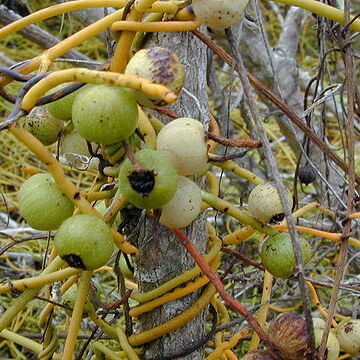Herbaceous, perennial, parasitic, partly autotrophic twiners, attached to host by small elliptic haustoria. Stems filiform or terete. Leaves spirally arranged, clasping, minute, scaly. Inflorescence a panicle, spike, raceme, or reduced to sessile or stalked head; peduncle erect; bracts 3. Flowers bisexual, sessile or shortly pedicellate, with 1 bract and 2 bracteoles. Perianth segments 6, free, persistent; sepals 3, scale-like, similar to floral bracts; petals 3, larger, fleshy. Receptacular tube: in flower turbinate, shallow-concave, tapering into pedicel and continuing into petals; after fertilisation becoming fleshy and enlarged to enclose ovary. Stamens and staminodes 12, in 4 whorls of 3; outer fertile whorls 3 (or 2); inner sterile whorls (staminodes) 1 (or 2); anthers 2-locular, dehiscing by an operculum; glands ovoid, at each side of base of filaments in third whorl. Carpel erect, white; ovary globular; style short, capitate. After fertilisation ovary forming crustaceous pericarp (bony putamen) which is enclosed by the tube of the fleshy receptacle. Fruit globular, bearing on top the lignified perianth and androecium sometimes encircled by a glandular rim. Seeds lacking endosperm; cotyledons thick, hemispherical, fleshy.
Vines , parasitic, with threadlike stems. Leaves reduced to minute scales, spirally arranged, glabrous or pubescent. Inflorescences spikes [panicles or racemes], rarely reduced to single flower. Flowers bisexual, sessile or shortly pedicellate, subtended by bract and 2 bracteoles; tepals persistent at apex of accrescent floral tube that surrounds fruit, greenish white or whitish, outermost row similar to bracts, innermost row larger; stamens 9 (or 6), anthers 2-locular, anthers of outer 6 stamens introrse, of inner 3 extrorse; staminodes 3 (or 6); ovary globose. Drupe black, globose, enclosed in floral tube, remnants of perianth apical.

